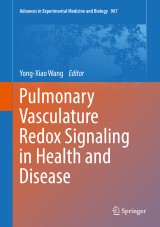Details

Pulmonary Vasculature Redox Signaling in Health and Disease
Advances in Experimental Medicine and Biology, Band 967
|
149,79 € |
|
| Verlag: | Springer |
| Format: | |
| Veröffentl.: | 18.10.2017 |
| ISBN/EAN: | 9783319632452 |
| Sprache: | englisch |
Dieses eBook enthält ein Wasserzeichen.
Beschreibungen
<p>The main goal of this book is to form a high-quality platform in which well-known and emerging pioneering basic, translational and clinical scientists can present their latest, exciting findings in the studies of redox signaling in the pulmonary vasculature. Content from outstanding investigators with unique expertise and skills of molecular and cell biology, biochemistry, physiology, pharmacology, biophysics, biotechnology and medicine will update our current out-of-date concepts with new knowledge. Rapidly increasing scientific studies have gathered a large volume of novel and important information on redox signaling in healthy and diseased pulmonary vasculature. This volume covers the need for a cohesive book to display state-of-the-art advances in the field. </p>The second major aim of this book is to help direct future research. Redox signaling is a major molecular process involved in almost every physiologic cellular response in the pulmonary vasculature including energy metabolism, host defense, gene expression, contraction, proliferation, and migration. Aberrancy in this important signaling pathway leads to a critical role in the development of nearly all pulmonary diseases, such as pulmonary hypertension, cor pulmonale, pulmonary edema, and vasculitis, among others. <p></p><p><br/></p>
<p>Chapter1. Adventitial Fibroblast Nox4 Expression and ROS Signaling in Pulmonary Arterial Hypertension.- Chapter2. Role of Transcription Factors in Pulmonary Artery Smooth Muscle Cells: An important Link to Hypoxic Pulmonary Hypertension.- Chapter3. Molecular Basis of Nitrative Stress in the Pathogenesis of Pulmonary Hypertension.- Chapter4. Pentose Shunt, Glucose-6-phosphate dehydrogenase and NADPH redox, and Stem cells in Pulmonary Hypertension.- Chapter5. Redox regulation of the superoxide dismutases SOD3 and SOD2 in the pulmonary circulation. – Chapter6. A Brief Overview of Nitric Oxide and Reactive Oxygen Species Signaling In Hypoxia-Induced Pulmonary Hypertension.- Chapter7. Altered redox balance in the development of chronic hypoxia- induced pulmonary hypertension.- Chapter8. ROS signaling in the pathogenesis of acute lung injury (ALI) and acute respiratory distress syndrome (ARDS).- Chapter9. Redox-dependent calpain signaling in airway and pulmonary vascular and remodeling inCOPD.- Chapter10. Natural antioxidants as potential therapy, and a promising role for melatonin against pulmonary hypertension.- Chapter11. Effects of Hyperoxia on the Developing Airway and Pulmonary Vasculature.- Chapter12. Lung ischemia/reperfusion injury – the role of reactive oxygen species.- Chapter13. Redox Mechanisms Influencing cGMP Signaling in Pulmonary Vascular Physiology and Pathophysiology.- Chapter14. Metabolic Reprogramming and Redox Signaling in Pulmonary Hypertension.- Chapter15. Hydrogen sulfide as an O2 sensor: a critical analysis.- Chapter16. Redox Signaling and Persistent Pulmonary Hypertension of the Newborn.- Chapter17. Crosstalk between mitochondrial reactive oxygen species and sarcoplasmic reticulum calcium in pulmonary arterial smooth muscle cells.- Chapter18. Endothelial Cell Reactive Oxygen Species and Ca2+ Signaling in Pulmonary Hypertension.- Chapter19. Redox signaling in the right ventricle.- Chapter20. Hypoxia and Local Inflammation in Pulmonary ArteryStructure and Function.- Chapter21. From physiological redox signalling to oxidant stress.- Chapter22. Emerging Role of MicroRNAs and Long Noncoding RNAs in Healthy and Diseased Lung.- Chapter23. Techniques for Detecting Reactive Oxygen Species in Pulmonary Vasculature Redox Signaling.- Chapter24. Mitochondrial and metabolic drivers of pulmonary vascular endothelial dysfunction in pulmonary hypertension.- Chapter25. Subcellular Redox Signaling.- Chapter26. Reactive oxygen species in COPD-related vascular remodeling.</p>
Dr. Yong-Xiao Wang is a Full Professor in the Department of Molecular and Cellular Physiology at Albany Medical College, Albany, New York, USA. He received his M.D. at the Wannan Medical College (China), Ph.D. at the Fourth Military Medical University (China), and postdoctoral training at the Technical University of Munich (Germany) as well as the University of Pennsylvania (USA). Dr. Wang’s primary research interests have focused on basic, translational, and drug discovery research concerning cardiac arrhythmias and hypertrophy, pulmonary hypertension, asthma, and diabetes for over 30 years. In particular, he has had extensive research experience in the studies of the molecular geneses, regulatory mechanisms, network pathways, physiological functions, and the critical roles of calcium, redox, inflammatory, and other signaling in the aforementioned illnesses. Dr. Wang has been the corresponding author, first author, and key contributor in numerous publications in highly peer-reviewed journals including Antioxid Redox Signal, Proc Natl Acad Sci USA, Free Radic Biol Med, Cell Calcium, J Gen Physiol, J Biol Chem, FASEB J, Nature, Circ Res, and more. He has been the editor of several academic books in the field including a recent one entitled “Calcium Signaling in Airway Smooth Muscle Cells” that was published by Springer in 2014. Dr. Wang has been the principal investigator on multiple research grants and awards from the National Institutes of Health, American Heart Association, American Diabetes Association, and other agencies. He has collaborated with numerous well-known scientists, served on various grant review panels, been the Editor-In-Chief and Editorial Board Member for several scientific journals, and trained a number of scholars, some of whom have become well-known independent investigators in the field.
Written by a collection of international experts in basic and translations research in pulmonary vasculature Comprehensive review of current and emerging developments in the field Provides invaluable information on an important signaling pathway with a critical role in nearly all pulmonary diseases
Diese Produkte könnten Sie auch interessieren:

The Neural Crest and Neural Crest Cells in Vertebrate Development and Evolution

von: Brian K. Hall

149,79 €















